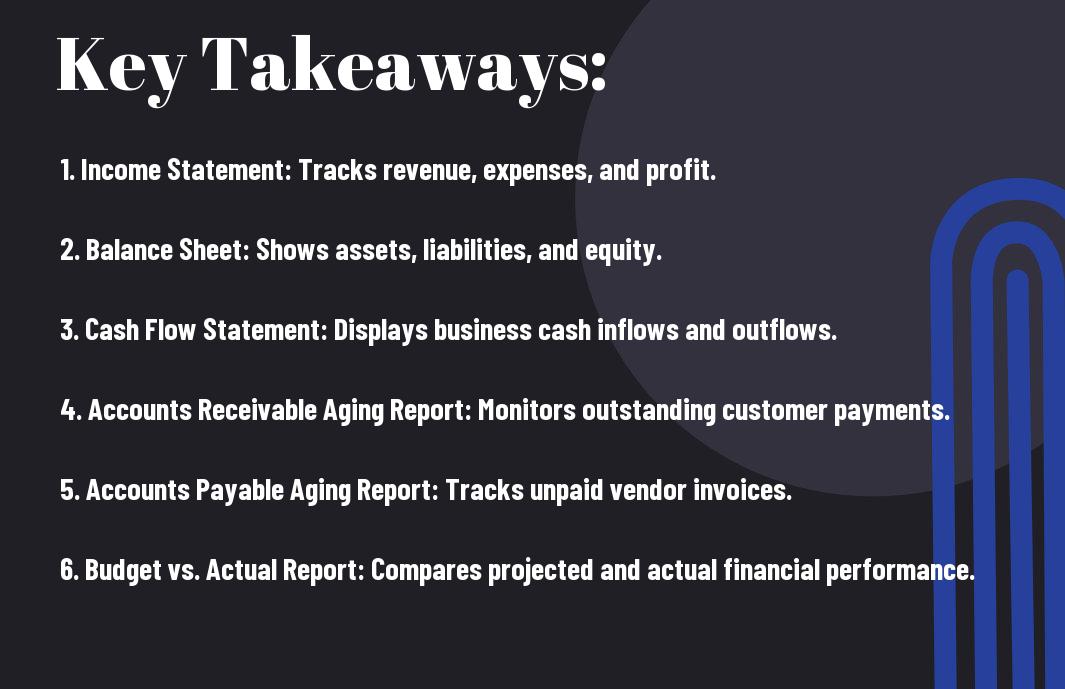What are the key financial reports that small business owners should monitor regularly?
If you want to ensure the financial health and growth of your small business, it is crucial that you stay on top of key financial reports. Monitoring these reports regularly will provide you with insight into the financial performance of your business, as well as help you make informed decisions and identify any potential issues before they become serious problems.
The three most important financial reports that small business owners should monitor regularly are the income statement, balance sheet, and cash flow statement. These reports provide vital information about your business’s revenue and expenses, assets and liabilities, and cash position. By keeping a close eye on these reports, you can identify trends, manage cash flow, make strategic decisions, and communicate effectively with stakeholders. Stay tuned for our upcoming blog posts where we will delve into each of these financial reports in more detail.
Key Takeaways:
- Profit and Loss Statement: Small business owners should regularly monitor their profit and loss statement to track their company’s revenue, expenses, and overall profitability. This report helps to identify areas of financial strength and weakness within the business.
- Cash Flow Statement: Monitoring the cash flow statement is essential for small business owners as it provides a detailed breakdown of the company’s cash inflows and outflows. By keeping an eye on cash flow, business owners can ensure that there is enough liquidity to cover expenses and invest in growth opportunities.
- Balance Sheet: Small business owners should regularly review their balance sheet to assess their company’s assets, liabilities, and equity. This report provides a snapshot of the business’s financial position at a specific point in time and helps in making informed decisions about the company’s financial health and future strategy.


The Balance Sheet
The balance sheet is a crucial financial report that provides a snapshot of your business’s financial position at a specific point in time. It consists of three main components: assets, liabilities, and owner’s equity. Monitoring your balance sheet regularly can help you track your business’s financial health and make informed decisions to drive growth and profitability.
Understanding Assets
Assets represent what your business owns and can be used to generate future revenue. They can include cash, accounts receivable, inventory, property, plant, equipment, and intangible assets such as patents or trademarks. By understanding your assets, you can assess your liquidity, leverage them to secure financing, or make strategic investment decisions. Having a healthy balance of liquid and fixed assets is crucial for your business’s operational flexibility and long-term sustainability.
Deciphering Liabilities and Owner’s Equity
Liabilities are what your business owes to creditors, suppliers, and other stakeholders. On the other hand, owner’s equity represents the investment the owner has made in the business and any retained earnings. By analyzing your liabilities and owner’s equity, you can determine how much of your assets are financed through debts and evaluate your business’s solvency and leverage ratios. Monitoring your liabilities and owner’s equity can help you ensure that your business has a healthy debt-to-equity ratio and is not overleveraged.
Analyzing the Balance Sheet for Financial Health
When you analyze your balance sheet, you can calculate key financial ratios such as current ratio, quick ratio, debt-to-equity ratio, and return on equity. These ratios provide insight into your business’s liquidity, financial stability, and profitability. Identifying trends in your financial ratios can help you address potential cash flow issues, manage debt responsibly, and make informed decisions to improve your business’s financial health.
The Income Statement
To effectively monitor the financial health of your small business, you need to regularly review key financial reports. One of the most important reports is the income statement, also known as the profit and loss statement. This report provides a summary of your company’s revenues, expenses, and profits during a specific period of time, typically on a monthly, quarterly, or annual basis.
Revenue Tracking and Its Significance
Tracking your revenue is critical for understanding the financial performance of your small business. By monitoring your sales, you can identify trends, determine which products or services are driving growth, and make informed decisions about pricing and marketing strategies. Additionally, consistent and reliable revenue tracking allows you to forecast future cash flow and set realistic financial goals for your business.
Expenses and Cost Management
Managing your expenses is equally important as tracking your revenue. By closely monitoring your costs, you can identify areas where you may be overspending or inefficient, and take corrective actions to improve your bottom line. It’s essential to keep a close eye on variable and fixed expenses, including rent, utilities, payroll, supplies, and other operational costs. Implementing cost-saving measures can significantly impact your profitability and long-term financial success.
Analyzing Profitability through Net Income
Net income, also known as the bottom line, is a key metric for assessing the overall profitability of your small business. This figure represents the amount of profit your company generates after deducting all expenses from your total revenue. Understanding your net income allows you to evaluate the efficiency of your operations and make informed decisions about investments, expansion, and future growth strategies. By analyzing your net income, you can gain valuable insights into the financial health of your business and take proactive steps to maximize profitability.
Cash Flow Statement
After reading about the importance of financial reports in our previous blog post on The 7 Most Important Financial Reports for Small Businesses, it’s time for you to delve into the specifics of each report. The cash flow statement is one of the most crucial financial reports that you, as a small business owner, should monitor regularly.
Operating Activities and Cash Management
Operating activities on your cash flow statement show the company’s ability to generate cash from its core business operations. This section includes cash received from customers, payments to suppliers, and operating expenses. Monitoring this section is crucial for managing your day-to-day cash flow, as it provides a clear picture of how your business is performing in terms of cash generation from its primary activities. By keeping a close eye on this aspect, you can identify any potential issues early on and take corrective actions to avoid cash flow crunches.
Investing and Financing Activities
The investing and financing activities section of the cash flow statement details cash flows related to your company’s investments and financial activities. This includes purchases or sales of assets, loans taken or repaid, and equity raised from investors. Paying attention to this section is essential for identifying your long-term investment and financing decisions. It allows you to evaluate how much money you are investing back into the business and whether you are managing your debt and equity positions effectively.
Interpreting Cash Flows for Liquidity Analysis
Interpreting the cash flows for liquidity analysis is an integral part of effectively managing your business’s finances. The cash flow statement provides you with valuable insights into your company’s ability to meet its short-term financial obligations and the availability of cash for future investments. By carefully analyzing the cash flow patterns, you can make well-informed decisions about how to optimize your working capital and ensure that your business is financially sustainable in the long run.
Statement of Retained Earnings
Despite being less commonly discussed than other financial reports, the Statement of Retained Earnings is a crucial document for small business owners to monitor regularly. This statement outlines the changes in a company’s retained earnings over a specific period, including dividends, profits, and losses.
Linking Net Income and Dividends
One of the key aspects of the Statement of Retained Earnings is the link between the company’s net income and dividends. When you review this statement, you can see how much of the net income is being reinvested back into the business and how much is being distributed to shareholders in the form of dividends. This information is essential for understanding the company’s dividend policy and the impact it has on the business’s financial health. If your business consistently pays out more in dividends than it earns in net income, it can lead to financial instability and potential cash flow issues. On the other hand, retaining a portion of the earnings can provide the capital necessary for business growth and expansion.
Evaluating Retained Earnings for Growth Potential
When evaluating the Statement of Retained Earnings, you should also consider the retained earnings as a measure of the business’s growth potential. A consistent increase in retained earnings over time indicates that the business is generating profits and retaining a portion of those earnings for future growth initiatives. On the other hand, a declining trend in retained earnings may signal that the company is facing financial challenges or experiencing decreasing profitability. This information is valuable for making informed decisions about investment, expansion, and business development.
Accounts Receivable Aging Report
Your Accounts Receivable Aging Report is a crucial financial document that provides insight into the payment status of your customers. It categorizes your outstanding receivables based on the length of time they have been outstanding, allowing you to track the aging of your invoices and identify potential issues with late payments.
Tracking Customer Payments
By regularly reviewing your Accounts Receivable Aging Report, you can keep a close eye on the status of customer payments. This allows you to follow up with customers who are late on their payments and take necessary actions to ensure that you receive the funds you are owed. Additionally, tracking customer payments helps you identify any recurring patterns of late payments from specific customers, enabling you to implement strategies to improve payment performance.
Identifying Potential Credit Risks
Monitoring your Accounts Receivable Aging Report also helps you identify potential credit risks within your customer base. By analyzing the report, you can pinpoint customers who consistently pay late or have a history of delinquent payments. This insight is invaluable for evaluating the creditworthiness of your customers and making informed decisions about whether to extend credit to them in the future. It also allows you to mitigate potential losses by adjusting credit terms or pursuing alternative payment arrangements with high-risk customers.

Inventory Management Reports
However, as a small business owner, monitoring your inventory is crucial for maintaining a healthy cash flow and maximizing profitability. Inventory management reports provide you with valuable insights into the movement of your products, allowing you to make informed decisions about purchasing, pricing, and stocking levels.
Understanding Inventory Turnover
One key metric to track in your inventory management reports is inventory turnover. This measures the number of times your inventory is sold and replaced over a specific period. A high inventory turnover indicates that your products are selling quickly, while a low turnover may indicate that you are holding onto too much inventory or that your products are not selling as well as expected. By tracking your inventory turnover, you can identify slow-moving items and make adjustments to your purchasing and pricing strategies to optimize sales.
Optimizing Stock Levels for Better Cash Flow
Another crucial aspect of inventory management is ensuring that you have the right level of stock on hand. Holding excess inventory ties up your cash and reduces your liquidity, while stocking out of popular items can lead to missed sales opportunities. By analyzing your inventory management reports, you can identify trends in product demand and adjust your stocking levels accordingly. This can help you maintain optimal stock levels, improve your cash flow, and ensure that you are meeting customer demand.
Budget vs. Actuals Performance Reports
Now let’s delve into the importance of comparing your budgeted financial performance against your actual financial results. This type of reporting is essential for understanding how well your small business is managing its financial resources and achieving its goals.
Setting Financial Targets
When you’re creating your business budget, you should be setting clear financial targets for each area of your operations – sales, expenses, profits, and cash flow. These targets serve as benchmarks against which you can measure your actual performance. By setting specific, measurable, achievable, relevant, and time-bound (SMART) financial goals, you create a roadmap for your business’s financial success.
Measuring Actual Performance Against Budget
One of the key purposes of budget vs. actuals performance reports is to measure how your small business is performing in reality compared to the targets you’ve set in your budget. This allows you to identify any areas where performance is below expectations and take corrective actions before small issues turn into major problems. You can identify opportunities for growth and improvement by analyzing the differences between your actual financial results and your budgeted amounts. By consistently tracking these variations, you can gain a clear idea of your business’s financial health and make informed decisions to steer it in the right direction.
Tax Reporting Documents
Your tax reporting documents are essential for ensuring compliance with tax laws, as well as for accurately reporting your business’s financial position. These documents include income statements, balance sheets, cash flow statements, and any other financial reports that are necessary for tax reporting purposes. By regularly monitoring these reports, you can ensure that you are prepared for tax season and can take advantage of any available tax-saving opportunities.
For more insights on the key financial reports that small business owners should review regularly, you can refer to this detailed article on 7 Financial Reports Business Owners Should Review Regularly.
Preparing for Tax Season with Accurate Reports
Accurate financial reports are the cornerstone of a successful tax season. By regularly monitoring these reports, you can ensure that your records are up to date and accurate, making the tax filing process much smoother. You can also identify any discrepancies or errors early on, allowing you to address them before they become major issues. This proactive approach not only saves you time and stress during tax season but also minimizes the risk of penalties or audits from the IRS.
Understanding Tax Obligations and Saving Opportunities
Understanding your tax obligations is crucial for maintaining compliance with the law and avoiding potential penalties. By monitoring your financial reports regularly, you can gain a clear understanding of your tax obligations and ensure that you have the necessary funds set aside for tax payments. Additionally, you can identify tax-saving opportunities through strategic financial planning. This may include deductions, credits, or other tax-saving strategies that can help minimize your tax liability and improve your overall financial position.
Conclusion
Ultimately, as a small business owner, it is crucial for you to regularly monitor key financial reports to ensure the financial health and success of your business. By keeping a close eye on your income statement, balance sheet, and cash flow statement, you can gain valuable insights into the profitability, liquidity, and overall financial performance of your business.
Through consistent monitoring of these financial reports, you can make informed decisions, identify potential financial challenges early on, and take proactive steps to mitigate any risks. By staying on top of these critical financial metrics, you can effectively manage your business finances and pave the way for long-term growth and success.
FAQ
Q: What are the key financial reports that small business owners should monitor regularly?
A: Small business owners should regularly monitor their income statement, balance sheet, and cash flow statement to gain a comprehensive understanding of their financial health and performance.
Q: Why is it important for small business owners to monitor these financial reports?
A: Monitoring these financial reports allows small business owners to assess their profitability, track their assets and liabilities, and ensure they have enough cash to cover ongoing expenses. This helps in making informed decisions and identifying areas for improvement.
Q: How often should small business owners review these financial reports?
A: Small business owners should review their financial reports at least monthly to stay informed about their financial position. This helps in identifying any trends, addressing issues early, and making necessary adjustments to improve financial performance.


